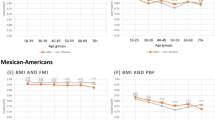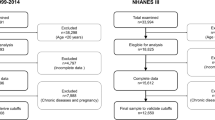Abstract
OBJECTIVES: To compare the different correlations of body mass index (BMI) and percent body fat (BF%) with other ethnic groups and to evaluate the appropriateness of Asia-Pacific redefining obesity criteria in the Taiwanese population. The corresponding BF% to BMI cutoffs of overweight and obesity will also be studied.
DESIGN: A cross-sectional epidemiological survey.
SUBJECTS: A total of 509 male and 570 female Taiwanese subjects aged ≥20 y sampled by the systematic stratified clustering sampling method were analyzed.
MEASUREMENTS: BMI was obtained by body weight (kg) divided by squared body height (m2). The estimated BMI (BMIe) was deduced from the Caucasian-based four-compartment equation (4C). BF% measured by the methods of dual-energy X-ray absorptiometry (DXA) or Caucasian-based 4C were used and abbreviated as DXA-BF and 4C-BF, respectively.
RESULTS: The curvilinear relationship between age and BMI or DXA-BF was established. When compared by age-stratified groups, Taiwanese subjects had a higher BF% (4C-BF) in any given BMI than Caucasians. That is, the level of 4C-BF for BMI≥25 kg/m2 in Taiwanese subjects was similar to BMI≥30 kg/m2 in Caucasians. The BMIe values of 25 and 30 kg/m2 were nearly equal to the BMIs of 23.6 and 25.3 kg/m2 in males, and 22.7 and 24.8 kg/m2 in females, respectively. The 4C-BF of 25% was nearly equal to a BMI of 26.2 kg/m2 in males, and 35% was equal to a BMI of 24.4 kg/m2 in females. Consequently, the DXA-BF cutoffs for BMIs of 23 and 25 kg/m2 were compatible to 23 and 25% in males, and 35 and 38% in females, respectively.
CONCLUSION: It was demonstrated that Taiwanese subjects had a relatively lower BMI but a higher BF% than Caucasians. In general, the newly proposed Asia-Pacific BMI cutoffs for overweight (≥23 kg/m2) and obesity (≥25 kg/m2) may be acceptable to both male and female Taiwanese subjects. The corresponding BF% (DXA-BF) cutoffs for obesity would be 25% in male and 38% in female Taiwanese subjects, respectively.
This is a preview of subscription content, access via your institution
Access options
Subscribe to this journal
Receive 12 print issues and online access
$259.00 per year
only $21.58 per issue
Buy this article
- Purchase on Springer Link
- Instant access to full article PDF
Prices may be subject to local taxes which are calculated during checkout



Similar content being viewed by others
References
World Health Organization. Obesity: preventing and managing the global epidemic. Report of a WHO consultation on obesity, Geneva, 3–5 June, 1997. WHO: Geneva, 1998.
Seidell JC, Kahn HS, Williamson DF, Lissner L, Valdez R . Report from a center for disease control and prevention workshop on use of adult anthropometry for public health and primary health case. Am J Clin Nutr 2001; 73: 123–126.
Wang J, Thorton JC, Russell M, Burastero S, Heymsfield S, Pierson Jr RN . Asians have lower body mass index (BMI) but higher percent body fat than do whites: comparisons of anthropometric measurements. Am J Clin Nutr 1994; 60: 23–28.
Guricci S, Hartriyanti Y, Hautvast JGAJ, Deurenberg P . Relationship between body fat and body mass index: differences between Indonesians and Dutch Caucasians. Eur J Clin Nutr 1998; 52: 779–783.
Gallagher D, Heymsfield SB, Heo M, Jebb SA, Murgatroyd PR, Sakamoto Y . Healthy percentage body fat ranges: an approach for developing guidelines based on body mass index. Am J Clin Nutr 2000; 72: 694–701.
Deurenberg-Yap M, Schmidt G, van Staveren WA, Deurenberg P . The paradox of low body mass index and high body fat percentage among Chinese, Malays and Indians in Singapore. Int J Obes 2000; 24: 1011–1017.
WHO. World Health Statistics 1996. WHO: Geneva, 1998.
Deurenberg-Yap M, Tan BY, Chew SK, Deurenberg P, van Staveren WA . Manifestation of cardiovascular risk factors at low levels of body mass index and waist–hip ratio in Singaporean Chinese. Asia Pacific J Clin Nutr 1999; 8: 177–183.
Deurenberg P, Deurenberg-Yap M, van Staveren WA . Body mass index and percent body fat: a meta-analysis among different ethnic groups. Int J Obes Relat Metab Disord 1998; 22: 1164–1171.
Setting Committee of the WHO Western Pacific Region, IASO & IOTF. The Asia-Pacific perspective: redefining obesity and its treatment. Health Communications Australia Pty Limit, Australia, 2000.
He M, Tan KCB, Li ETS, Kung AWC . Body fat determination by dual energy X-ray absorptiometry and its relation to body mass index and waist circumference in Hong Kong Chinese. Int J Obes Relat Metab Disord 2001; 25: 748–752.
Lu FH, Yang YC, Wu JS, Wu CH, Chang CJ . A population-based study of the prevalence and associated factors of diabetes mellitus in southern Taiwan. Diabet Med 1998; 15: 564–572.
Chang CJ, Wu CH, Lu FH, Wu JS, Chiu NT, Yao WJ . Discriminating glucose tolerance status by ROIs of DEXA: clinical implications of body fat distribution. Diabetes Care 1999; 22: 1938–1943.
Wu CH, Yao WJ, Lu FH, Wu JS, Chang CJ . Relationship between glycosylated hemoglobin, blood pressure, serum lipid profiles and body fat distribution in healthy Chinese. Atheroslecrosis 1998; 137: 157–165.
Ley CJ, Lees B, Stevenson JC . Sex- and menopause-associated changes in body-fat distribution. Am J Clin Nutr 1992; 55: 950–954.
Heymsfield SB, Lichtman S, Baumgartner RN, Wang J, Kamen Y, Aliprantis A, Pierson Jr RN . Body composition of humans: comparison of two improved four-compartment models that differ in expense, technical complexity, and radiation exposure. Am J Clin Nutr 1990; 52: 52–58.
Allison DB, Zhu SK, Plankey M, Faith MS, Heo M . Differential associations of body mass index and adiposity with all-cause mortality among men in the first and second National Health and Nutrition Examination Surveys (NHANES I and NHANES II) follow-up studies. Int J Obes Relat Metab Disord 2002; 26: 410–416.
Mott JW, Wang J, Thornton JC, Allison DB, Heymsfield SB, Pierson Jr RN . Relation between body fat and age in 4 ethnic groups. Am J Clin Nutr 1999; 69: 1007–1013.
Park YW, Allison DB, Heymsfield SB, Gallagher D . Larger amounts of visceral adipose tissue in Asian Americans. Obes Res 2001; 9: 381–387.
Lohman TG . Advances in body composition assessment, current issues in exercise science series. Human Kinetics Publishers: Champaign, IL, 1992.
Kuczmarski R, Flegal KM . Criteria for definition of overweight in transition: background and recommendations for the United States. Am J Clin Nutr 2000; 72: 1074–1081.
Kohrt WM . Body composition by DXA: tried and true? Med Sci Sports Exerc 1995; 27: 1349–1353.
Svendsen OL, Haarbo J, Hassager C, Christiansen C . Accuracy of measurements of body composition by dual-energy X-ray absorptiometry in vivo. Am J Clin Nutr 1993; 57: 605–608.
He M, Li ET, Kung AW . Dual-energy X-ray absorptiometry for body composition estimation in Chinese women. Eur J Clin Nutr 1999; 53: 933–937.
Deurenberg-Yap M, Schmidt G, van Staveren WA, Hautvast JG, Deurenberg P . Body fat measurement among Singaporean Chinese, Malays and Indians: a comparative study using a four-compartment model and different two-compartment models. Br J Nutr 2001; 85: 491–498.
Acknowledgements
This study was supported by grants NSC 90-2314-B-006-104, NSC 89-2314-B006-044, and NSC 89-2314-B006-208. We thank colleagues of the Department of Family Medicine, NCKUH, for help in this epidemiological survey.
Author information
Authors and Affiliations
Corresponding author
Rights and permissions
About this article
Cite this article
Chang, CJ., Wu, CH., Chang, CS. et al. Low body mass index but high percent body fat in Taiwanese subjects: implications of obesity cutoffs. Int J Obes 27, 253–259 (2003). https://doi.org/10.1038/sj.ijo.802197
Received:
Revised:
Accepted:
Published:
Issue Date:
DOI: https://doi.org/10.1038/sj.ijo.802197
Keywords
This article is cited by
-
“Does Religious Service Attendance Modify the Relationship between Everyday Discrimination and Risk of Obesity? Results from the Study on Stress, Spirituality and Health”
Journal of Racial and Ethnic Health Disparities (2023)
-
Obesity and individual performance: the case of eSports
International Journal of Obesity (2022)
-
Revisional large gastric pouch with Roux-en-Y gastric bypass for patients with type 2 diabetes and a body mass index less than 35 kg/m2: a cause and effect analysis
Surgery Today (2022)
-
Comparison of anthropometric and body composition indices in the identification of metabolic risk factors
Scientific Reports (2021)
-
Parental and Child Characteristics Predicting Asian immigrants’ Feeding Practices
Journal of Child and Family Studies (2021)



